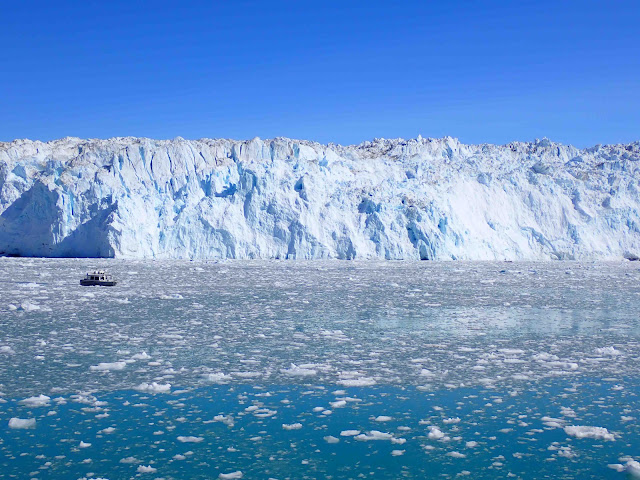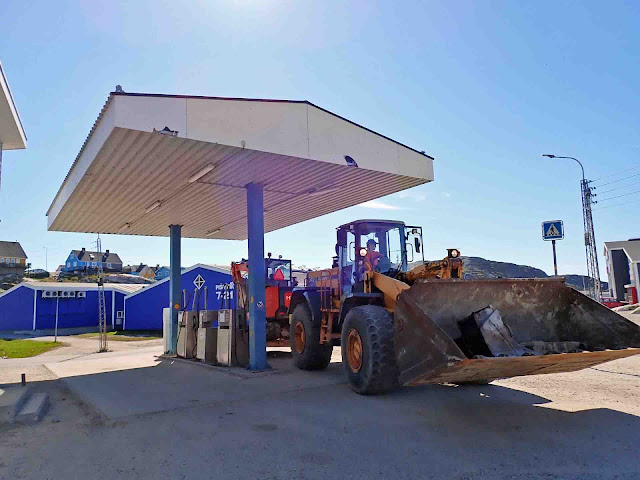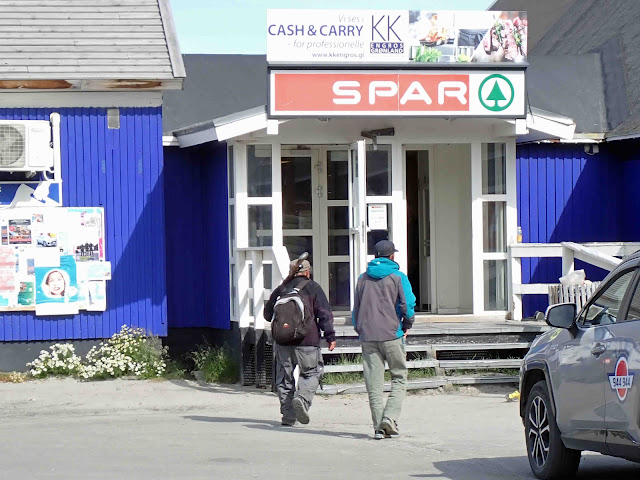Next stop after Ilulissat was Kangerlussuaq. You think that's a strange name? You should hear how it's pronounced!
The first sign that something was a bit strange was after I booked the hotel at Kangerlussuaq months ago. I wrote to them asking how we get from the airport to the hotel The answer was, and I quote, "The hotel is located in the same building as the airport, no need for transfer." What??????
Once we knew this, we looked at google maps and realised that the whole town is based around a really long airstrip. There are buildings along both sides of the airstrip and that's it! The Americans built a huge runway here in 1941 and it's now Greenland's main international airport, although that's all about to change with international airports being built elsewhere.
Sure enough, we landed at the airport, picked up our bags then followed a few signs to the hotel reception, without leaving the terminal. The receptionist wasn't particularly helpful or friendly and, as we made our way down long dilapidated corridors to our room, I was thinking "Oh no - we've got four nights here!" Walls were cracked and we had to carry bags up and down flights of stairs. It was reminiscent of Fawlty Towers.
Dinner was - you guessed it - in the airport. On night one I was starting to feel like Tom Hanks in that movie where he can't leave the airport terminal. It was so weird! We returned to our room and I realised the room smelled exactly like the motel rooms I used to stay in 30 years ago for work! It's not a bad smell but I really don't know what it is. Again, so weird!
Not only does Kangerlussuaq have Greenland's longest runway but it also has Greenland's longest road. In the 1990's, Volkswagen thought the ice cap would be an ideal place to test cars so they built a road from the town to the ice cap, 37kms away. They then built a road on the ice cap. They didn't seem to realise that the ice cap is not a permanent surface and after having to re-build the road on the ice cap every year for a few years they gave up. The legacy they left behind though is a good dirt road so people like us can access the ice cap.
We aren't normally people who do organised tours but there's no other way to get around so we signed up for a tour of the ice cap. We duly met our guide, Pawel, at the appointed hour. To our delight, we learned that the only other person on the trip was an Aussie woman. The four of us piled into an ancient Land Rover and headed off along the long road.
The views were amazing! We passed pretty lakes and cool mountains.
Pawel showed us some 400 year-old Inuit graves. They are always buried above ground, which makes sense as it's almost impossible to dig through this rock. Plus the permafrost isn't far below the surface.
We passed two huge glaciers, including Russell Glacier.
Arriving at the edge of the ice cap, we strapped on harnesses and crampons and headed out onto the ice.
Pawel was an enthusiastic and patient guide who knew this ice cap incredibly well. He's so passionate about it that he brings tourists here most days then comes here by himself or with friends on his days off.
We didn't really know what to expect but I was surprised at how much the terrain varied.
We found a patch of "rock flour", rock that has been ground up incredibly fine by the pressure of the ice cap. It was strange stuff.
We walked up hills, across ridges and down gullies.
Much to our amazement, we were shown a number of moulins. These are huge holes formed by meltwater drilling holes in the ice. Pawel put an ice screw in the ice and we clipped into it and used it to lean against so we could peer over the edge of the moulin. It was so cool!
Inside, the water had bored through the dense blue ice forming a long vertical drop.
The water formed a river before pouring into the moulin.

The variety in the landscape was amazing! Two Aussies on the other side of the world.
These amazing holes are formed where rock flour sits under the snow. Being darker, the rock flour absorbs heat and melts small holes, maybe up to 15cms across, in the show. Some of these freeze over trapping air bubbles inside. They're so pretty!
There were a few lakes and this one was a stunning blue.
There was even a small cave. I love the deep blue ice at the back of it!
We were tethered again to look over the edge of a gorge.
At another gorge we laid on our stomachs to peer over the edge! I noticed Pawel stood close by in case we did anything stupid.
Of course it was another incredible view of a river-formed canyon over the edge.
A cool shot of our intrepid leader.
At one point we straddled a narrow gorge and walked up it. It wasn't easy!
The blue of this lake was incredible!
We had to jump this river. John and I got a bit wet, haha.
We couldn't go near this moulin as it had dangerous sloping edges and was 50 metres deep!
A very happy team!
After four or five hours on the ice we returned to the car, tired but totally thrilled. Woohoo! On our return, we stopped at a gorgeous spot where a couple of waterfalls were backed by a glacier.
A cup of tea with a view.
Musk ox and reindeer live in this area. We didn't think we would see either of them on this trip but we saw two of each although they were a long way away. We saw them through binoculars. Much to our surprise, an arctic fox ran across the road in front of us at one stage! This was a huge bonus as it's not so common to see them.
And lastly, there was one lake that contained "sea tomatoes' which are actually a type of cyanobacteria which can release toxins into the lake.

It was a truly incredible day full of adventure and wonder!
The next day was largely free so we hiked up a nearby hill. It was a long walk just to get around the airport!
We saw these unusual signs. This one means that when a plane takes off or lands we're not allowed on the road which is right at the end of the runway.
Much to our amazement there were warning signs about quicksand!
We saw these cool feathery plants. They gave a splash of colour on a largely green/grey landscape.
We took lunch with us and ate it at a picnic table overlooking the valley. They seem to have a lot of these tables. The bloody mossies liked us though!
We then jumped on a huge 4WD bus to do a tour to see wildlife. We knew this tour wouldn't be our cup of tea but there was no other way to get out and see things. We lasted 100 metres then got off. The sound system, where the driver talks to the passengers in the back, was super loud and distorted. It was awful! There are always going to be times that aren't so great and this was one of them.
The town is so unusual in many ways. The longer we stayed, the more we realised that everything is owned by the one company. The hotel, the cafeteria, the restaurants and the tours were all owned by the same company. And it's all there for no other reason that it has a long airstrip that can land large planes. There is a new international airport almost ready at Nuuk, the capital, and another one is being constructed now at Ilulissat. Once these open, this town will be vastly different. It only has a population of about 500 now and I'm sure that nearly all of those work in something to do with the business created by the airport. I don't know if the town will survive the change. I'm also not sure if that's a bad thing seeing it only came to life in the second world war.
About six kms from the town is a restaurant set on a beautiful lake. Once a week they have a Greenlandic buffet which is very popular. The same company owns that and we were transported there by one of the company's buses. The food was interesting - there were dishes like reindeer liver pate and roast musk ox - but the people were wonderful, especially the bus driver and the barman. We had a lovely night chatting to a Danish woman who is working in the cafeteria for six weeks, just for the experience.
The next day was overcast and drizzly so we put our coats on and climbed up the hill that we look at from our room. The views up the valleys and across to the fjord were amazing!
The town has two distinct parts with the runway dividing it. This is our side where the accommodation, restaurants and planes are! The other side of the airstrip is more the industrial area.
As we came back into town another arctic fox ran between the buildings! This is as good a shot as I could get in the few seconds that I had. We later saw it near this area again.
They're pretty cute. This isn't my photo.
And this is a musk ox, again, taken from the internet. They get hunted a lot here as they're great eating. There's no room for vegetarians in this country!
The hotel seemed really full again that evening and we learned that strong winds in Nuuk were preventing flights coming in so 150 people were stranded in our tiny town of Kangerlussuaq. At 5pm there were three beds left in the whole town.
The next day, the backlog of passengers had to be got out, even though the winds hadn't improved much. We were also flying to Nuuk this day so we kept a nervous eye on the flights going out. Everything to Nuuk was delayed but they did seem to leave eventually.
While we waited we were entertained by events on the airstrip. We watched as passengers walked out on the tarmac to their plane within 50 metres of a departing large plane. Later there was a cacophony of sirens on the tarmac. Three fire trucks and emergency vehicles had their sirens sounding and lights flashing. Oh no - was there some sort of disaster? Nope - they were just giving a special send off to someone!
We finally boarded our plane, the only flight to Nuuk for the day that wasn't delayed! Woohoo!











































































































